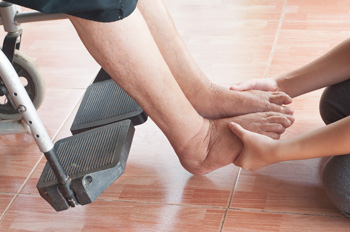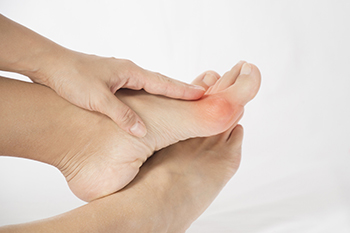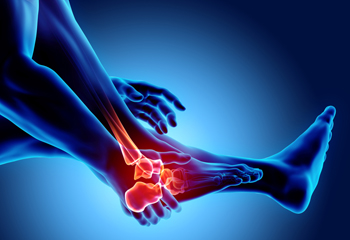Foot and Ankle Specialist
November 2021
How Do I Keep My Toddler From Falling?
When it comes to falling and the many foot and ankle injuries associated with it, the elderly are not the only group at risk. Young children fall frequently as they learn to walk, climb, run, and explore the world around them. While you may not be able to prevent every fall, you can take steps to prevent any major injuries. Around the home, lock doors that lead to dangerous areas and use sliding gates on stairways. Ensure that all carpets and rugs are held securely in place to prevent tripping or slipping. Keep hallways, stairs, and walking areas around the house free of clutter. Keep an eye on your child while they play and don’t allow them to climb high furniture. For more information about preventing falls for your loved ones of all ages, please consult with a podiatrist.
Preventing falls among the elderly is very important. If you are older and have fallen or fear that you are prone to falling, consult with Don A. Shumway, DPM from Arizona. Our doctor will assess your condition and provide you with quality advice and care.
Every 11 seconds, an elderly American is being treated in an emergency room for a fall related injury. Falls are the leading cause of head and hip injuries for those 65 and older. Due to decreases in strength, balance, senses, and lack of awareness, elderly persons are very susceptible to falling. Thankfully, there are a number of things older persons can do to prevent falls.
How to Prevent Falls
Some effective methods that older persons can do to prevent falls include:
- Enrolling in strength and balance exercise program to increase balance and strength
- Periodically having your sight and hearing checked
- Discuss any medications you have with a doctor to see if it increases the risk of falling
- Clearing the house of falling hazards and installing devices like grab bars and railings
- Utilizing a walker or cane
- Wearing shoes that provide good support and cushioning
- Talking to family members about falling and increasing awareness
Falling can be a traumatic and embarrassing experience for elderly persons; this can make them less willing to leave the house, and less willing to talk to someone about their fears of falling. Doing such things, however, will increase the likelihood of tripping or losing one’s balance. Knowing the causes of falling and how to prevent them is the best way to mitigate the risk of serious injury.
If you have any questions, please feel free to contact our office located in Snowflake, AZ . We offer the newest diagnostic and treatment technologies for all your foot care needs.
Read more about Falls PreventionIt's Time for Beautiful Feet
Elderly Foot Care Basics
Helping take care of an elderly person’s feet is very important for their overall health and well being. Toenails should be trimmed and filed, and feet should be moisturized. A warm foot bath will not only be relaxing, but relieve achy feet and help increase blood flow. Be sure to keep any foot hygiene tools and equipment sanitized. Never share these tools and equipment with anyone. Socks and shoes need to fit properly, and never be too tight. Socks should always be washed after every use to avoid fungi or infections from developing. Feet should be checked daily for wounds, cracked skin, bleeding sores and discolored nails. These can all be indicators of an infection. A podiatrist should be part of any elderly person’s health care team, and regular check ups and examinations can help avoid problems in the future.
Proper foot care is something many older adults forget to consider. If you have any concerns about your feet and ankles, contact Don A. Shumway, DPM from Arizona. Our doctor can provide the care you need to keep you pain-free and on your feet.
The Elderly and Their Feet
As we age we start to notice many changes in our body, but the elder population may not notice them right away. Medical conditions may prevent the elderly to take notice of their foot health right away. Poor vision is a lead contributor to not taking action for the elderly.
Common Conditions
- Neuropathy – can reduce feeling in the feet and can hide many life-threatening medical conditions.
- Reduced flexibility – prevents the ability of proper toenail trimming, and foot cleaning. If left untreated, it may lead to further medical issues.
- Foot sores – amongst the older population can be serious before they are discovered. Some of the problematic conditions they may face are:
- Gouging toenails affecting nearby toe
- Shoes that don’t fit properly
- Pressure sores
- Loss of circulation in legs & feet
- Edema & swelling of feet and ankles
Susceptible Infections
Diabetes and poor circulation can cause general loss of sensitivity over the years, turning a simple cut into a serious issue.
If you have any questions please feel free to contact our office located in Snowflake, AZ . We offer the newest diagnostic and treatment technologies for all your foot and ankle needs.
Read more about Elderly Foot CareThe Many Possible Causes of Ankle Pain
Ankle discomfort can manifest as pain, stiffness, swelling, bruising, redness, tingling, or an inability to put weight on the ankle. There are several possible causes of ankle pain with the most common being sprains and strains of the ankle’s ligaments, and fractures of one or more bones in the ankle. Achilles tendon ruptures are another possible cause of ankle pain. They can occur when the Achilles tendon tears away from the heel bone which can cause swelling, bruising, and pain in the ankle. Rheumatoid arthritis, where the body’s immune system attacks the lining on the inside of the joint capsule, can occur in the ankle joint and be quite painful. Another form of arthritis—gout—causes a painful buildup of hardened uric acid crystals to deposit on joints, which can occur not only in the big toe, but the ankle joint as well. A bacterial infection (sometimes referred to as septic arthritis) may also set in the ankle joint, causing cartilage and bone damage, and pain. It is highly suggested that you seek the care of a podiatrist to determine the source and receive treatment for any ankle pain or discomfort you may be experiencing.
Ankle pain can have many different causes and the pain may potentially be serious. If you have ankle pain, consult with Don A. Shumway, DPM from Arizona. Our doctor will assess your condition and provide you with quality foot and ankle treatment.
Ankle pain is any condition that causes pain in the ankle. Due to the fact that the ankle consists of tendons, muscles, bones, and ligaments, ankle pain can come from a number of different conditions.
Causes
The most common causes of ankle pain include:
- Types of arthritis (rheumatoid, osteoarthritis, and gout)
- Ankle sprains
- Broken ankles
- Achilles tendinitis
- Achilles tendon rupture
- Stress fractures
- Tarsal tunnel syndrome
- Plantar fasciitis
Symptoms
Symptoms of ankle injury vary based upon the condition. Pain may include general pain and discomfort, swelling, aching, redness, bruising, burning or stabbing sensations, and/or loss of sensation.
Diagnosis
Due to the wide variety of potential causes of ankle pain, podiatrists will utilize a number of different methods to properly diagnose ankle pain. This can include asking for personal and family medical histories and of any recent injuries. Further diagnosis may include sensation tests, a physical examination, and potentially x-rays or other imaging tests.
Treatment
Just as the range of causes varies widely, so do treatments. Some more common treatments are rest, ice packs, keeping pressure off the foot, orthotics and braces, medication for inflammation and pain, and surgery.
If you have any questions, please feel free to contact our office located in Snowflake, AZ . We offer the newest diagnostic and treatment technologies for all your foot care needs.
What to Consider Before Bunion Surgery
A bunion is a common foot deformity characterized by a bony bump that forms at the base of the big toe joint. The bump can become inflamed, red, swollen, and painful. It also pushes the big toe out of alignment, so that it is tilted toward the smaller toes instead of pointing straight ahead. Bunions progressively worsen without treatment, and surgery is often the only option to permanently remove them. That said, there are many things to consider prior to making the decision to operate. Certain underlying health conditions, such as diabetes, rheumatoid arthritis, and gout, can increase the risk of complications from surgery. It is also important to think about your lifestyle. Do you intend to wear high heels, exercise, or stand for prolonged periods of time? These factors can help your podiatrist determine if bunion surgery is the right treatment option for you. For more information about bunions, please consult with a podiatrist.
If you are suffering from bunions, contact Don A. Shumway, DPM of Arizona. Our doctor can provide the care you need to keep you pain-free and on your feet.
What Is a Bunion?
A bunion is formed of swollen tissue or an enlargement of boney growth, usually located at the base joint of the toe that connects to the foot. The swelling occurs due to the bones in the big toe shifting inward, which impacts the other toes of the foot. This causes the area around the base of the big toe to become inflamed and painful.
Why Do Bunions Form?
Genetics – Susceptibility to bunions are often hereditary
Stress on the feet – Poorly fitted and uncomfortable footwear that places stress on feet, such as heels, can worsen existing bunions
How Are Bunions Diagnosed?
Doctors often perform two tests – blood tests and x-rays – when trying to diagnose bunions, especially in the early stages of development. Blood tests help determine if the foot pain is being caused by something else, such as arthritis, while x-rays provide a clear picture of your bone structure to your doctor.
How Are Bunions Treated?
- Refrain from wearing heels or similar shoes that cause discomfort
- Select wider shoes that can provide more comfort and reduce pain
- Anti-inflammatory and pain management drugs
- Orthotics or foot inserts
- Surgery
If you have any questions, please feel free to contact our office located in Snowflake, AZ . We offer the newest diagnostic and treatment technologies for all your foot care needs.
Read more about BunionsRheumatoid Arthritis in the Feet
Rheumatoid Arthritis is a chronic progressive disease that causes pain, stiffness, and swelling in joints. It often emerges first in smaller joints such as those in the feet and hands. Left untreated, this painful condition may cause erosions in the affected joint, changes in the foot’s shape, and mobility issues. A podiatrist can help manage the pain of rheumatoid arthritis while helping maintain and improve the foot’s functionality and mobility. The treatment options a podiatrist may utilize include custom orthotics, physical therapy, bracing, compression, pain relievers, steroid injections, and even surgery to correct extensive damage. If you have pain in any joint in your foot or ankle make an appointment right away with a podiatrist. Early diagnosis and treatment can help reduce the chances of future deformity and disability.
Because RA affects more than just your joints, including the joints in your feet and ankles, it is important to seek early diagnosis from your podiatrist if you feel like the pain in your feet might be caused by RA. For more information, contact Don A. Shumway, DPM of Arizona. Our doctor will assist you with all of your podiatric concerns.
What Is Rheumatoid Arthritis?
Rheumatoid Arthritis (RA) is an autoimmune disorder in which the body’s own immune system attacks the membranes surrounding the joints. Inflammation of the lining and eventually the destruction of the joint’s cartilage and bone occur, causing severe pain and immobility.
Rheumatoid Arthritis of the Feet
Although RA usually attacks multiple bones and joints throughout the entire body, almost 90 percent of cases result in pain in the foot or ankle area.
Symptoms
- Swelling and pain in the feet
- Stiffness in the feet
- Pain on the ball or sole of feet
- Joint shift and deformation
Diagnosis
Quick diagnosis of RA in the feet is important so that the podiatrist can treat the area effectively. Your doctor will ask you about your medical history, occupation, and lifestyle to determine the origin of the condition. Rheumatoid Factor tests help to determine if someone is affected by the disease.
If you have any questions please feel free to contact our office located in Snowflake, AZ . We offer the newest diagnostic and treatment technologies for all your foot and ankle needs.
Read more about Rheumatoid Arthritis in the Feet











